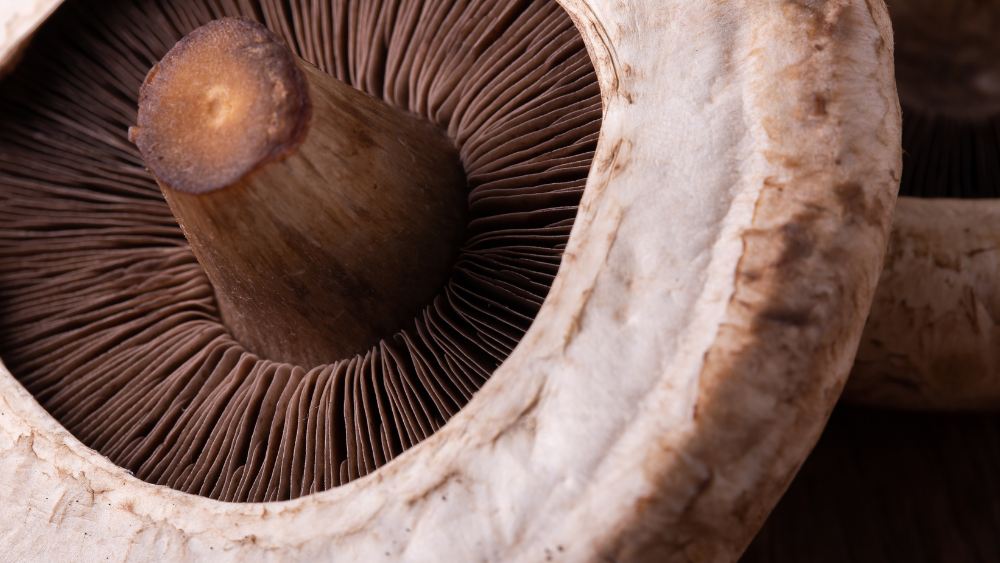October 16, 2024 | Dr. Silvana Jakupovic, ND
Portobello mushrooms are known for their rich, savoury flavour and meaty texture, making them versatile ingredients in various cuisines. Many people may not realize that these culinary delights are mature, common white mushrooms. Their caps expand as the white mushrooms grow, developing a unique flavour and texture.
Scientifically known as Agaricus bisporus, portobello mushrooms are among the most widely cultivated and consumed mushrooms in the United States and worldwide. The United States alone produces over a billion pounds of mushrooms annually, with portobellos accounting for a significant portion.
Portobellos are commonly grown in controlled environments, unlike many other mushrooms that thrive in damp, dark environments. This controlled cultivation ensures a consistent supply of high-quality mushrooms throughout the year, making them a readily available and affordable culinary staple.
What’s the Difference Between a Portobello Mushroom and a Regular Mushroom?
Portobello mushrooms are easily distinguishable from other mushroom varieties due to their impressive size, meaty texture, and dark brown colour. When young, they resemble common white button mushrooms, but as they mature, their caps expand, reaching up to six inches in diameter. This expansive growth allows the portobello to develop its characteristic meaty texture, making it an ideal meat substitute in vegetarian and vegan dishes.
Another distinguishing feature of portobellos is their deep, umami flavour. Umami, often called the fifth taste, is a savoury, brothy, or meaty taste sensation that adds a depth of flavour to various dishes. Portobellos are particularly rich in glutamates, compounds that trigger the umami taste.
Why is it Called a Portobello Mushroom?
The name "Portobello" mushroom is relatively modern and comes from clever marketing. In the 1980s, these large, mature brown mushrooms were not very popular and were often discarded or sold cheaply. To improve their appeal, marketers began rebranding them with more exotic names. The name "Portobello" was chosen because it sounded more appealing and sophisticated, helping elevate the mushroom's status and increase its desirability in the culinary world.
There’s also some ambiguity about the origin of the name, with some speculating that it may have been inspired by the Portobello Road area in London, known for its market and vibrant atmosphere. However, this connection remains more anecdotal than factual. The rebranding worked, and today, Portobello mushrooms are widely recognized and valued for their rich flavour and meaty texture.

Portobello vs. Cremini: What is Another Name for Portobello Mushrooms?
The connection between portobello and cremini mushrooms often needs clarification, as both names are used interchangeably. While they belong to the same species, the distinction lies in their maturity and size. Cremini mushrooms, also known as baby bella or crimini, are adolescent portobellos.
Imagine portobellos as the wise elders of the mushroom world while creminis are the vibrant adolescents. Regarding flavour, creminis offer a milder, more delicate taste than the robust, umami-rich portobellos. However, they share a similar earthy undertone. Regarding texture, creminis retain a slightly firmer bite than their mature counterparts.
What is Special About Portobello Mushrooms?
Beyond their culinary versatility, portobello mushrooms are a nutritional powerhouse, offering a wealth of essential vitamins, minerals, and antioxidants [1]. These mushrooms are naturally low in calories, fat, and sodium, making them a healthy addition to any diet. They are a good source of B vitamins and are vital in energy production, cell function, and overall well-being.
Essential Vitamins and Minerals in Portobellos
Portobello mushrooms are an excellent source of B vitamins, including riboflavin (B2), niacin (B3), and pantothenic acid (B5). Riboflavin is essential for maintaining healthy red blood cells, good vision, and healthy skin. Niacin supports the nervous system, digestive system, and skin health. Pantothenic acid is crucial for energy production, hormone synthesis, and maintaining a healthy nervous system.
In addition to B vitamins, portobellos are rich in essential minerals like potassium, copper, and selenium. Potassium maintains healthy blood pressure, muscle function, and fluid balance. Copper is involved in iron absorption, red blood cell formation, and maintaining healthy connective tissues. Selenium is an antioxidant that protects cells from damage and supports immune function.

Health Benefits of Portobello Mushrooms
The impressive nutrient profile of portobello mushrooms translates into a range of health benefits. These include boosting the immune system, aiding in weight management, and potentially reducing the risk of chronic diseases.
Boosting Immunity with Portobellos
Portobello mushrooms contain a unique type of antioxidant called selenium, crucial in supporting a healthy immune system. Selenium helps to reduce oxidative stress, which can weaken the immune response and make the body more susceptible to infections.
Furthermore, portobellos contain beta-glucans, a type of soluble fibre shown to enhance immune function [2]. Beta-glucans act as prebiotics, nourishing the beneficial bacteria in the gut and strengthening the body's defence mechanisms. A healthy gut microbiome is essential for optimal immune function, as a significant portion of the immune system is located in the gut.
Portobellos in Weight Management Plans
Incorporating portobello mushrooms into weight management plans is a smart move due to their low-calorie and high-fibre content. The fibre in portobellos adds bulk to meals, promoting a feeling of fullness and reducing overall calorie intake.
Moreover, portobellos' meaty texture and savoury flavour make them an excellent meat substitute. Replacing red meat with portobellos in recipes can significantly reduce calorie and fat intake without sacrificing flavour or satisfaction, making them a valuable tool for weight loss or maintenance.

Popular Portobello Mushroom Recipes
The versatility of portobello mushrooms extends to countless culinary creations, ranging from simple weeknight meals to impressive gourmet dishes. Their large caps make them ideal for grilling, stuffing, and baking, while their savoury flavour complements a wide range of cuisines.
Simple Grilled Portobello Mushrooms
Grilling portobello mushrooms is a great way to enhance their natural, savoury flavour. Clean the mushrooms, remove the stems, and marinate them in olive oil, balsamic vinegar, garlic, and herbs like thyme, rosemary, and oregano. Allow the mushrooms to marinate for at least 30 minutes to absorb the flavours.
Preheat the grill to medium heat and grill the mushrooms for 5-7 minutes per side or until tender and slightly charred. The grilling process intensifies the mushroom's umami flavour, creating a delicious and satisfying meat-free main dish or side. For a flavorful twist, experiment with different marinades like Asian-inspired ginger-soy or smoky chipotle lime.
Stuffed Portobello Mushrooms - A Healthy Delight
Stuffed portobello mushrooms are a healthy and satisfying meal option. Start by cleaning the mushrooms and removing the stems. Brush the caps with olive oil and season with salt, pepper, and desired herbs. Preheat the oven to 375°F (190°C).
The possibilities for the stuffing are endless. A classic choice combines sauteed spinach, garlic, onion, and mozzarella cheese. Other popular variations include quinoa and feta, sausage and cream cheese, or even a Mexican-inspired blend of black beans, corn, and Monterey Jack cheese. Fill the mushroom caps generously with the stuffing and bake for 20-25 minutes, until the mushrooms are tender and the stuffing is heated.
In conclusion, Portobello mushrooms are delicious and packed with essential nutrients that can benefit your health in various ways. Whether you enjoy them grilled, stuffed, or in other recipes, incorporating Portobellos into your diet can help boost your immunity and support weight management efforts. With their unique taste and nutritional profile, Portobello mushrooms offer a versatile option for adding flavour and health benefits to your meals. So, consider including these fantastic fungi for a nutritious twist next time you plan a healthy dish!
Frequently Asked Questions
Why are portobello mushrooms beneficial for health?
Portobello mushrooms contain antioxidants, B vitamins, dietary fibre, and protein. They are also a good source of vitamin D, particularly when exposed to sunlight. These nutrients contribute to various health benefits, including improved immunity and heart health.
Can portobello mushrooms be eaten raw?
While portobello mushrooms are safe to eat raw, they are often tougher and chewier than when cooked. Cooking them helps to soften their texture and enhance their flavour.
How to store portobello mushrooms for freshness?
Store portobello mushrooms in a paper bag or a container lined with paper towels in the refrigerator to maintain freshness. This helps to absorb excess moisture and extend their shelf life for up to a week.









Leave a comment
This site is protected by hCaptcha and the hCaptcha Privacy Policy and Terms of Service apply.